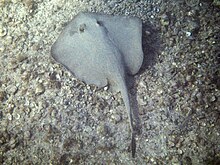Greenback stingaree
| Greenback stingaree | |
|---|---|

| |
| Scientific classification | |
| Domain: | Eukaryota |
| Kingdom: | Animalia |
| Phylum: | Chordata |
| Class: | Chondrichthyes |
| Subclass: | Elasmobranchii |
| Superorder: | Batoidea |
| Order: | Myliobatiformes |
| Family: | Urolophidae |
| Genus: | Urolophus |
| Species: | U. viridis
|
| Binomial name | |
| Urolophus viridis McCulloch, 1916
| |
The greenback stingaree (Urolophus viridis) is a little-known
Usually found over soft
Taxonomy
The greenback stingaree was described by Australian
Distribution and habitat
Once common, the greenback stingaree occurs in warm-
Description
The greenback stingaree has a diamond-shaped pectoral fin disc wider than long, with broadly rounded outer corners. The leading margins of the disc are nearly straight, and converge at an obtuse angle on the fleshy snout. The tip of the snout protrudes slightly past the disc. The eyes are large and followed by comma-shaped spiracles with rounded posterior margins. There is a skirt-shaped curtain of skin between the nostrils, with a finely fringed posterior margin; the posterior corners of the nasal curtain are extended into small lobes. The medium-sized mouth contains 4–7 variably shaped papillae (nipple-like structures) on the floor; additional papillae are found in a narrow strip on the lower jaw.[3] The teeth are small with roughly oval bases, and the five pairs of gill slits are short. The pelvic fins are small and rounded on their trailing margins.[3][4]
The tail is flattened at the base and measures 75–91% as long as the disc; a prominent skin fold runs along each side, and a deep, lance-shaped
Biology and ecology
The greenback stingaree preys mainly on
Human interactions
The greenback stingaree and the
References
- ^ . Retrieved 18 November 2021.
- ^ McCulloch, A.R. (October 31, 1916). "Report on some fishes obtained by the F.I.S. "Endeavour" on the coasts of Queensland, New South Wales, Victoria, Tasmania, South and South-Western Australia". Biological Results Endeavour. Part IV. 4 (4): 169–199.
- ^ ISBN 978-0-674-03411-2.
- ISBN 92-5-104302-7.
- S2CID 13499358.

